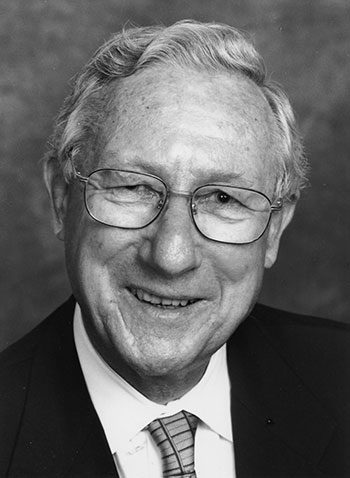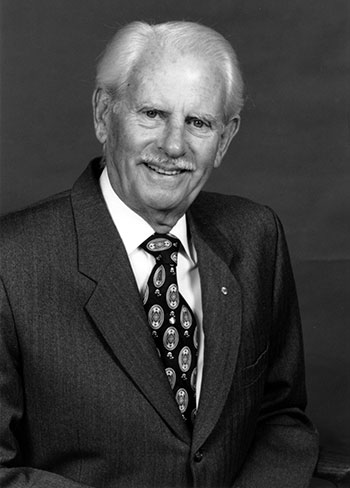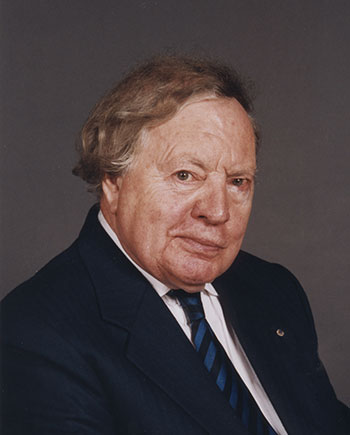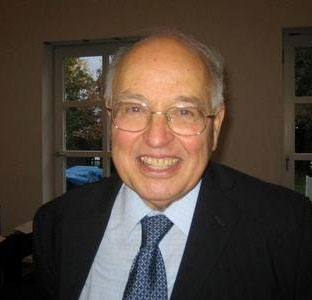Professor Marilyn Renfree AO FAA—Society for the Study of Reproduction's Carl G. Hartmann Award in recognition of a career of research and scholarly activities in the field of reproductive biology

Professor James Waldo Lance AO CBE FAA FRACP FRCP
29 October 1926 to 20 February 2019
Professor James ‘Jim’ Lance was elected to the Academy in 1980 for his contributions to neurology, particularly disorders of the motor system and headache mechanisms. He was the first Professor of Neurology in Australia. Professor Lance founded the neurology departments at the Prince Henry and Prince of Wales Hospitals, and his research on migraines led to work on serotonin and to the discovery of triptans—drugs used to treat migraines and cluster headaches.
Professor Lance was one of the founding members of the Brain Foundation which awards the James Lance Award for headache research each year. In 1977, Professor Lance was appointed a Commander of the Order of the British Empire (CBE) and in 1991, Officer of the Order of Australia. Professor Lance gave his time generously to the Academy, including serving on the Council and as Vice President.
Professor David Burke FAA interviewed Professor Lance for the Academy in 2010. The Sydney Morning Herald also published an obituary.

Sir Rupert Horace Myers KBE AO FAA FTSE
21 February 1921 to 21 February 2019
Sir Rupert Myers was a metallurgist and was awarded his PhD in 1948 by Melbourne University. This is widely acknowledged as the first PhD in science from an Australian university. Sir Rupert then took up an appointment in the UK where he worked on projects for the atomic power program, including development of processes which produced the first plutonium metal in the UK and the first pure uranium powder. He was Foundation Professor of Metallurgy at the University of New South Wales (1952–81) and served as the third Vice-Chancellor of UNSW (1969–81). He has been Emeritus Professor at UNSW since 1981.
Sir Rupert’s contributions to public life were extraordinary. He held numerous appointments on State and Commonwealth Government advisory committees, councils and committees of inquiry and chaired several bodies. He was also Director of the Prince Henry, Prince of Wales and Eastern Suburbs Hospitals (1966–83) and chaired well over a dozen company boards and foundations. Sir Rupert was also a patron of the Sydney Opera House Trust (1976–83), the Winston Churchill Memorial Trust (since 2000), and the Australian Trust for Conservation Volunteers (since 1986).
Sir Rupert was appointed a Commander of the Order of the British Empire (CBE) in 1976 and then a Knight Commander in the Most Excellent Order of the British Empire (KBE) in 1981 in recognition of his ‘service to education, science and the community’. He was appointed an Officer of the Order of Australia in 1995 for ‘service to the promotion of innovation and commerce in the fields of science technology and engineering’.
In 1979, Sir Rupert was elected to the Australian Academy of Technological Sciences and Engineering and served as Vice-President (1985–88) and then President of ATSE (1989–94). He was elected by Special Election to the Australian Academy of Science in 1997.

Professor Noel Sydney Hush AO FAA FRS FRSN
15 December 1924 to 20 March 2019
Since 1971, Professor Noel Hush worked at the University of Sydney where he founded a new department of Theoretical Chemistry, which became a centre for excellence in teaching from undergraduate to postdoctoral level and research. Upon his formal retirement in 1989, he was appointed Emeritus Foundation Professor of Theoretical Chemistry and he continued his full-time research. In 2002, he was also appointed convenor of the Molecular Electronics Group at the university. Professor Hush also held numerous prestigious visiting positions at other universities in Australia, the United Kingdom and the United States of America.
Professor Hush was elected to the Academy in 1977 for his outstanding contributions to chemical physics and theoretical chemistry, and his research in the area of electron transfer. He was an active Fellow of the Academy and served on several committees and working groups.
Professor Hush was elected to the Royal Society in 1988 and to the National Academy of Sciences as a Foreign Associate in 2011. He was made an Officer of the Order of Australia in 1993 and received the Academy’s Matthew Flinders Medal in 1994, the David Craig Medal in 2000 and the Welch Award in 2007. In 1999 he was elected as a Foreign Honorary Member to the American Academy of Arts and Sciences, and in 2014 he received the Ahmed Zewail Prize for Molecular Science.
Professor Hush was interviewed by Robyn Williams FAA in 2011. A transcript is available on the Academy’s website.

Sir Michael Francis Atiyah OM FRS FRSE FMedSci FAA FREng
22 April 1929 to 11 January 2019
Sir Michael Atiyah was widely regarded as one of the greatest mathematicians. He was known for his work in the areas of geometry and topology, and for his co-development of topological K-theory and the Atiyah-Singer index theorem.
At the age of 32, Sir Michael was elected to the Royal Society in 1962. He served as President of the Royal Society from 1990 to 1995 and joined the Academy as a Corresponding Member in 1992. He was Master of Trinity College, Cambridge (1990–1997), the first Director of the Isaac Newton Institute for Mathematical Sciences, Cambridge and Chancellor of the University of Leicester (1995–2005).
Sir Michael received numerous honours and awards during his career, including the Fields Medal (1966), the Copley Medal of the Royal Society (1988) and the Abel Prize (with Isadore Singer, 2004). He was knighted in 1983, received the Order of Merit in 1992 and was made a Grand Officier of the Légion d’honneur in 2011.
The Head of School of Mathematics, University of Edinburgh has published a tribute and other obituaries are available at The Guardian and BBC News.
© 2026 Australian Academy of Science